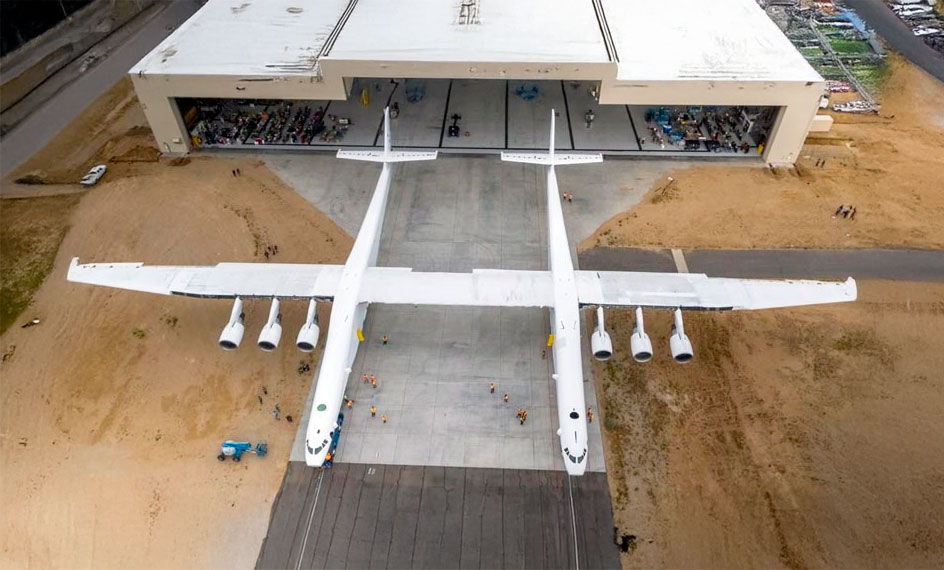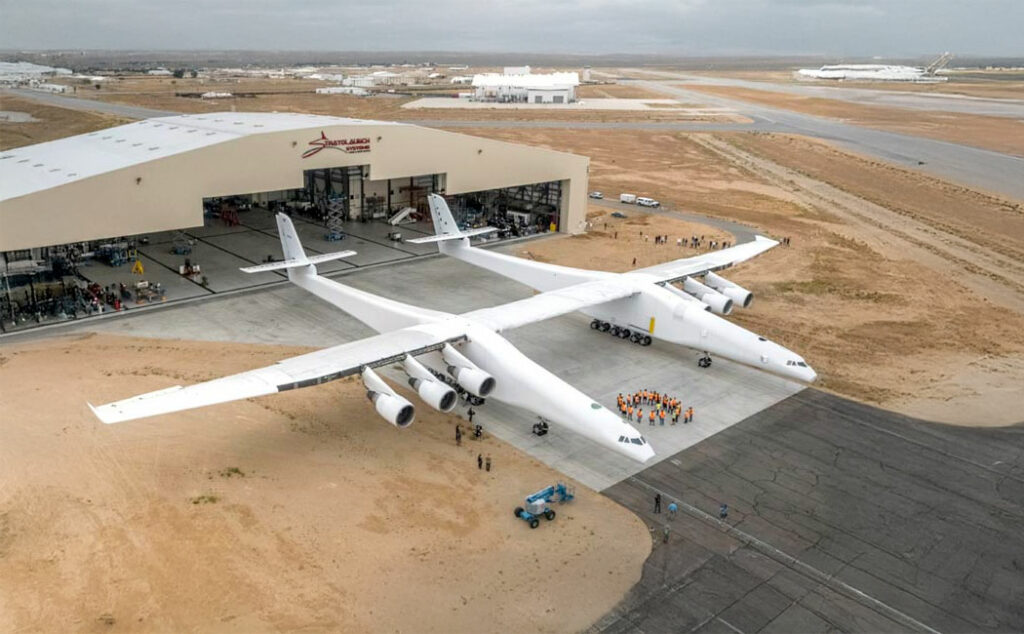The Stratolaunch Carrier Aircraft is a dual-fuselage, six-engine platform with a 385-foot wingspan, designed to air-launch rockets into orbit.
The Stratolaunch Carrier Aircraft, also known as the Model 351 or “Roc”, is a dual-fuselage aircraft developed by Scaled Composites for Stratolaunch Systems. It features a record-breaking wingspan of 385 feet (117 meters), making it the largest aircraft by wingspan ever constructed. Powered by six Pratt & Whitney PW4056 engines, it is designed to carry payloads up to 500,000 pounds (226,796 kilograms). The aircraft’s primary mission is to serve as a mobile launch platform, releasing rockets at high altitude to deliver satellites into low Earth orbit. Its design incorporates components from two Boeing 747-400 aircraft, including engines, landing gear, and avionics, to reduce development costs and leverage proven technology. The Stratolaunch first flew on April 13, 2019, demonstrating its potential to revolutionize access to space by enabling more flexible and cost-effective satellite deployment.
History of the Development of the Stratolaunch Carrier Aircraft
In the early 2010s, the aerospace industry was experiencing a resurgence of interest in private spaceflight, driven by technological advancements and decreasing costs. Recognizing the potential for more efficient satellite deployment, Paul G. Allen founded Stratolaunch Systems in 2011 with the vision of creating a flexible air-launch platform. The objective was to develop an aircraft capable of carrying rockets to high altitudes, where they could be launched into orbit, bypassing the limitations and costs associated with traditional ground-based launches.
To realize this vision, Stratolaunch partnered with Scaled Composites, an aerospace company renowned for innovative designs like SpaceShipOne. The project, internally designated as Model 351, aimed to construct the world’s largest aircraft by wingspan. The design featured a dual-fuselage configuration, drawing on components from two Boeing 747-400 aircraft, including engines, landing gear, and avionics, to leverage existing technology and reduce development costs.
Construction of the Stratolaunch Carrier Aircraft began in 2012 at the Mojave Air and Space Port in California. The project progressed steadily, with the massive aircraft taking shape over several years. On May 31, 2017, the Stratolaunch was officially unveiled to the public, showcasing its impressive size and unique design.
Tragically, Paul Allen passed away in October 2018, before witnessing the maiden flight of his ambitious project. Despite this loss, Stratolaunch Systems continued to advance the program. The Stratolaunch Carrier Aircraft achieved its first flight on April 13, 2019, taking off from the Mojave Air and Space Port. During this initial test flight, the aircraft reached an altitude of 15,000 feet (4,600 meters) and a speed of 190 mph (305 km/h) over a 2 hour 29 minute flight, successfully demonstrating its airworthiness and the feasibility of the air-launch concept.
Following the maiden flight, Stratolaunch underwent organizational changes, including a change in ownership and direction. In 2019, Jean Floyd took over as CEO, leading efforts to refocus the company’s mission. By early 2020, the company had grown to 87 employees, signaling a commitment to advancing the Stratolaunch platform.
The Stratolaunch Carrier Aircraft, nicknamed “Roc”, has since been repurposed to offer air-launch hypersonic flight testing services. This shift aligns with the growing interest in hypersonic technologies and the need for flexible testing platforms. As of 2025, the Stratolaunch continues to conduct test flights, contributing to advancements in aerospace technology and maintaining its status as the largest aircraft by wingspan ever constructed.

Design of the Stratolaunch Carrier Aircraft
The Stratolaunch Carrier Aircraft features a distinctive dual-fuselage design, measuring 238 feet (72.5 meters) in length and boasting a record-breaking wingspan of 385 feet (117 meters). Each fuselage is equipped with its own cockpit, although only the right fuselage is actively used for flight operations, housing the pilot and co-pilot, while the left fuselage remains unpressurized and is utilized for flight data systems.
The aircraft is powered by six Pratt & Whitney PW4056 turbofan engines, each providing a thrust of approximately 56,750 pounds-force (252.4 kN). These engines, along with other components such as the landing gear and avionics, are sourced from decommissioned Boeing 747-400 aircraft, a design choice aimed at reducing development costs and leveraging proven technology.
The landing gear system comprises 28 wheels, designed to distribute the aircraft’s substantial weight and facilitate operations from standard runways. The main landing gear includes 24 wheels, while each nose gear assembly has 2 wheels, ensuring stability during taxiing, takeoff, and landing.
The central wing section, spanning the space between the two fuselages, serves as the attachment point for payloads. This area is designed to carry rockets or other air-launch vehicles, with a payload capacity of up to 500,000 pounds (226,796 kilograms). The aircraft’s design allows it to transport and launch multiple payloads in a single mission, making it a versatile platform for various aerospace applications.
The wing structure, constructed primarily of composite materials, ensures the necessary strength-to-weight ratio to support the massive wingspan and payload capacity. The use of composite materials also contributes to fuel efficiency and structural durability. The wings house additional fuel tanks, extending the aircraft’s range and endurance.
The Stratolaunch’s cockpit in the right fuselage includes advanced avionics derived from the Boeing 747, ensuring reliability and familiarity for pilots. The flight controls are adapted to manage the unique dual-fuselage configuration, requiring precise coordination for smooth operations.
Despite its innovative design, the Stratolaunch Carrier Aircraft faces challenges, such as limited airport infrastructure capable of accommodating its size and weight. Additionally, the high operational costs and specialized nature of the aircraft restrict its widespread use. Nevertheless, its unique capabilities make it a critical asset for air-launch operations and hypersonic testing.
Performance of the Stratolaunch Carrier Aircraft
The Stratolaunch Carrier Aircraft is powered by six Pratt & Whitney PW4056 engines, each producing 56,750 pounds-force (252.4 kN) of thrust. These engines, originally designed for the Boeing 747-400, provide the necessary power to lift the massive aircraft and its payload. The total thrust output is approximately 340,500 pounds-force (1,515 kN).
The aircraft has a maximum takeoff weight (MTOW) of 1.3 million pounds (589,670 kilograms), including a payload capacity of 500,000 pounds (226,796 kilograms). This capacity allows the Stratolaunch to carry multiple rockets or large air-launch vehicles, making it one of the most capable payload carriers in aerospace.
With a wingspan of 385 feet (117 meters), the Stratolaunch requires extensive runway space for operations. It typically operates from facilities like the Mojave Air and Space Port, which are equipped to handle its size and weight. The aircraft’s length of 238 feet (72.5 meters) and height of 50 feet (15.2 meters) further emphasize its massive scale.
The cruising speed of the Stratolaunch is approximately 460 mph (740 km/h), with a maximum operating altitude of 35,000 feet (10,668 meters). These performance metrics align with the requirements for air-launch operations, providing the altitude and stability needed for rocket deployment.
The aircraft’s range is estimated at 2,500 nautical miles (4,630 kilometers) when fully loaded, enabling it to conduct missions over vast distances. The additional fuel tanks integrated into the wing structure ensure sufficient endurance for extended flights.
Compared to traditional ground-based rocket launches, the Stratolaunch offers several advantages, including the ability to bypass weather-related delays and access various orbital inclinations. Its air-launch capability reduces the need for fixed launch infrastructure, enhancing mission flexibility and reducing costs.
While the Stratolaunch excels in payload capacity and operational range, its size and specialized requirements limit its versatility. However, its performance parameters make it uniquely suited for specific applications, such as deploying multiple satellites in a single mission or supporting hypersonic flight testing.
Variants of the Stratolaunch Carrier Aircraft
The Stratolaunch Carrier Aircraft currently exists in a single configuration, known as the Model 351 or Roc. However, its modular design allows for potential customization and future variants to meet evolving aerospace needs.
- Baseline Model 351:
The original and only existing version, designed for air-launching rockets into orbit and hypersonic flight testing. It features the dual-fuselage structure, six engines, and a central wing section for payload attachment. - Hypersonic Testing Variant:
This potential variant would focus on carrying and deploying hypersonic test vehicles. While not formally designated as a separate model, Stratolaunch’s shift toward hypersonic testing services suggests that modifications may be introduced to optimize the aircraft for this role. - Heavy Payload Variant (Conceptual):
Future iterations could increase payload capacity or incorporate additional systems for carrying larger or more complex launch vehicles.
The Stratolaunch’s adaptable platform ensures that it remains relevant for emerging aerospace applications, with the flexibility to accommodate various payloads and mission profiles.

Military Use and Combat of the Stratolaunch Carrier Aircraft
The Stratolaunch Carrier Aircraft was primarily developed for commercial and scientific purposes, focusing on satellite deployment and hypersonic flight testing. As such, it does not carry armaments and has not been directly involved in military combat. However, its unique capabilities present potential military applications, particularly in hypersonic weapons development and rapid satellite deployment for defense purposes.
Hypersonic Testing
Stratolaunch’s recent focus on hypersonic flight testing aligns with global military interest in hypersonic technologies. The aircraft’s ability to deploy hypersonic test vehicles at high altitudes provides a valuable platform for evaluating the performance of advanced weapons and surveillance systems. This capability is particularly relevant in the context of increasing competition in hypersonic technology development among global powers.
Satellite Deployment for Defense
The Stratolaunch’s ability to deploy multiple satellites in a single mission offers strategic advantages for military operations. Rapid satellite deployment could support real-time intelligence, surveillance, and reconnaissance (ISR) missions, enhancing situational awareness in conflict zones.
Potential Military Variants
Although the Stratolaunch has not been adapted for military use, conceptual modifications could include integration with classified payloads, such as electronic warfare systems or missile defense platforms. These adaptations would extend the aircraft’s utility to military applications while maintaining its core air-launch capabilities.
Competing Aircraft
The Stratolaunch’s unique design and mission profile distinguish it from other heavy-lift aircraft like the Antonov An-225 and the Boeing 747 Dreamlifter, which focus on cargo transport rather than air-launch missions. Its closest conceptual competitor is Northrop Grumman’s Pegasus XL, which also supports air-launch operations but lacks the payload capacity and versatility of the Stratolaunch.
Current Status
As of 2025, the Stratolaunch Carrier Aircraft remains active, conducting hypersonic flight tests and supporting aerospace research initiatives. While its military applications are limited to indirect roles, its capabilities position it as a valuable asset for both commercial and strategic aerospace efforts.
The Stratolaunch Carrier Aircraft exemplifies innovation in aerospace engineering, delivering unmatched payload capacity and air-launch capabilities. Its record-breaking wingspan, coupled with advanced design features, ensures its effectiveness in deploying satellites and supporting hypersonic research. While its operational scope is currently limited to non-combat roles, the Stratolaunch’s potential for adaptation underscores its relevance in advancing aerospace and defense technologies.
Back to the Special Aircraft section